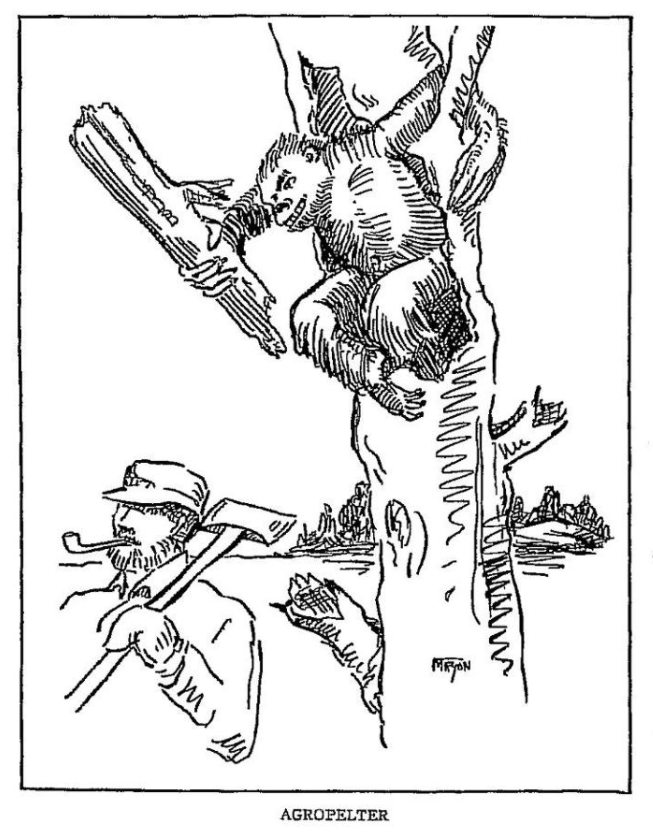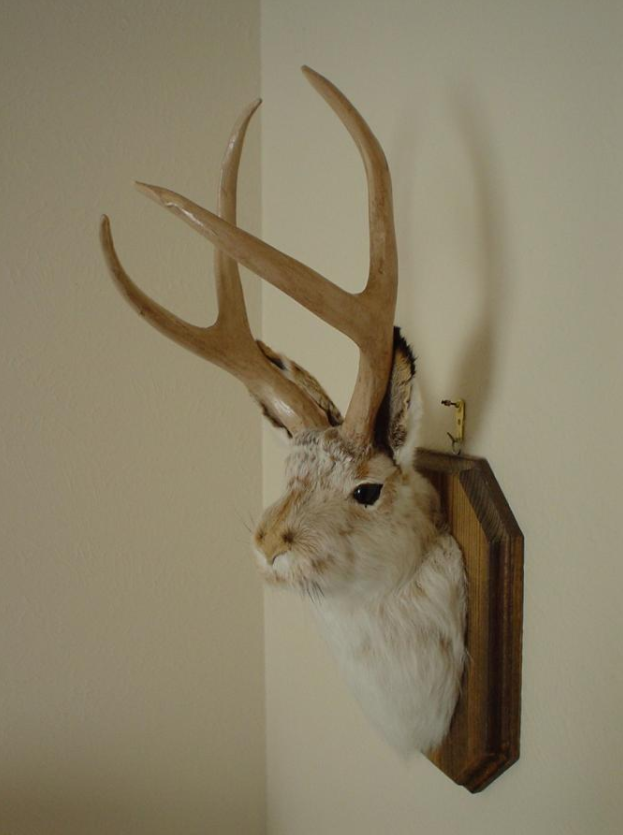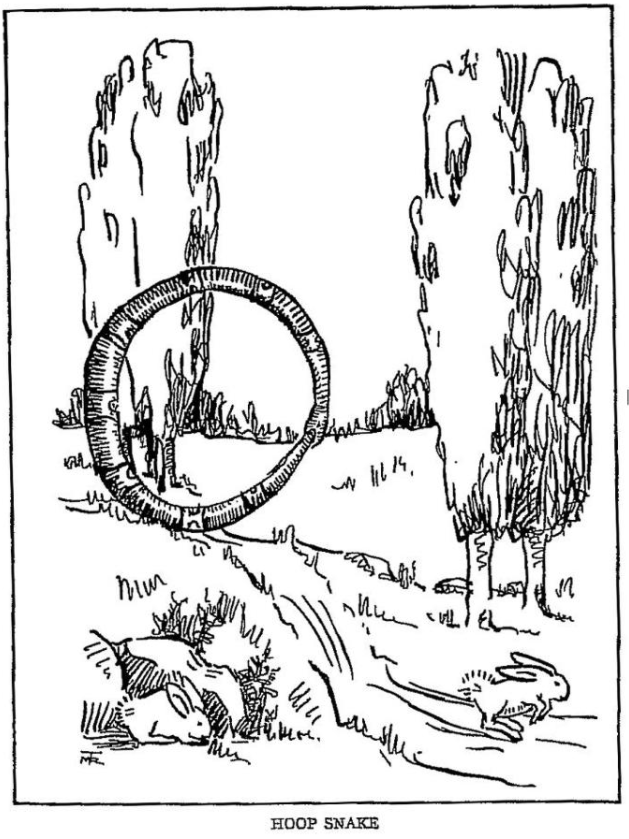
| Version | Summary | Created by | Modification | Content Size | Created at | Operation |
|---|---|---|---|---|---|---|
| 1 | Vivi Li | -- | 1490 | 2022-11-01 01:41:25 |
Video Upload Options
In North American folklore, fearsome critters were tall tale animals jokingly said to inhabit the wilderness in or around logging camps, especially in the Great Lakes region. Today, the term may also be applied to similar fabulous beasts.
1. Origins
Fearsome critters were an integral part of oral tradition in North American logging camps during the turn of the twentieth century,[1] principally as a means to pass time (such as in tall tales)[2] or as a jest for hazing newcomers.[3] In a typical fearsome critter gag, a person would casually remark about a strange noise or sight they encountered in the wild, and another accomplice would join in with a similar anecdote. Meanwhile, an eavesdropper would begin to investigate, as Henry H. Tryon recorded in his book, Fearsome Critters (1939) —
Sam would lead with a colorful bit of description, and Walter would follow suit with an arresting spot of personal experience, every detail being set forth with the utmost solemnity, and with exactly the correct degree of emphasis. At the end, so deftly had the cards been played that the listener was completely convinced of the animal's existence. This method of presentation is widely used. For the best results, two narrators who can "keep the ball in the air" are necessary, and perhaps an occasional general question is tossed to someone in the audience, such inquiries being invariably accorded a grave, corroborative nod.[3]
Lumberjacks, who regularly traveled between camps, would stop to swap stories, which eventually disseminated these myths across the continent.[2] Many fearsome critters were simply the products of pure exaggeration; however, a number were used either jokingly or seriously as explanations for both unexplained and natural phenomena. For example, the hidebehind served to account for loggers who failed to return to camp,[4][5] while the treesqueak offered justification for strange noises heard in the woods.[3] A handful whether intentionally or unknowing mirrored descriptions of actual animals. The mangrove killifish, which takes up shelter in decaying branches after leaving the water,[6] exhibits similarities to the upland trout, a legendary fish purported to nest in trees.[7] In addition, the story of the fillyloo, about a mythical crane that flies upside-down, may have been inspired by observations of the wood stork, a bird that has been witnessed briefly flying in this manner.[8] In particular instances more elaborate ruses were created using taxidermy[9] or trick photography.[10]
2. Attributes

The character of the fearsome critters themselves was usually more comical than frightful.[1] Often the greater emphasis is placed on behavioral traits with little or no detail mentioned on their appearance, as in the cases of the hidebehind, teakettler,[11] squidgicum-squee,[12] and hangdown.[4] Some fearsome critters like flittericks or the goofus[5] appeared to be ordinary animals that just behaved out of the ordinary. The more physically emphasized and improbable creatures seem to be distinguished by how far the storyteller could push the boundaries of biomechanics. Both the tripodero[4] and snoligoster[2] demonstrate facets more in common with mechanical apparatuses than animals, and the hugag and sidehill gouger[3] seem to be more a play on applied physics than fanciful inspiration. While much of the literature that has been written on the subject echoes a naturalist's perspective, commonly specifying a range of distribution, behavioral habits, and physical appearance,[2][3][7] many of these myths were never as widespread as others. Consequently, it is common to find a lack of consensus on a specific fearsome critter, if not clear contradictions. To illustrate, the wampus cat differs widely in appearance depending on region. For instance, in Henry H. Tryon's Fearsome Critters, the wampus cat is described as having pantographic forelimbs[3] while in Vance Randolph's We Always Lie to Strangers, it is portrayed a supernatural, aquatic panther.[8]
The tendency to description of behavior without image is used to eerie literary effect by Manly Wade Wellman in employing a number of fearsome critters in his 1952 science fiction folk tale "The Desrick on Yandro," as well as commenting specifically on the lack of physical description for one of the beasts: "The Behinder flung itself on his shoulders. Then I knew why nobody's supposed to see one. I wish I hadn't. To this day I can see it, as plain as a fence at noon, and forever I will be able to see it. But talking about it's another matter. Thank you, I won't try."
3. Firsthand Accounts
In his 1939 book, Fearsome Critters, Henry H. Tryon recounted that "... much true folk-lore was born, lived and died with no chance of ever becoming a part of our permanent records. Without doubt this has happened to a good bit of woods lore." Consequently, firsthand records on fearsome critters are few in number. However, among some of the more significant sources to record fearsome critter stories directly from loggers, hunters and other forest tradesmen, listed chronologically, are:
- Fearsome Creatures of the Lumberwoods, With a Few Desert and Mountain Beasts, by William T. Cox (Washington, D.C.: Judd & Detweiler Inc., 1910)
- Fearsome Critters, by Henry H. Tryon (Cornwall, NY: Idlewild Press, 1939)
- The Hodag and Other Tales of the Logging Camps, by Lakeshore Kearney (Madison, WI: Democrat Printing Company, 1928)
- Paul Bunyan Natural History, by Charles E. Brown (Madison, WI: self-published, 1935)
- We Always Lie to Strangers, by Vance Randolph (New York: Columbia University Press, 1951)
- Mythical Creatures of the USA and Canada, by Walker D. Wyman (River Falls, WI: Univ of Wisconsin Riverfalls Press, 1978)
Additionally, in 1922 and 1925, veteran guide Art Childs published an illustrated newspaper column entitled, Yarns of the Big Woods that featured fearsome critters from oral traditions. Additionally, many of the aforementioned texts has since been made freely available online, yet others are still under copyright.
4. List


4.1. Beasts
- Agropelter, a beast that amuses itself by hurling twigs and tree branches at passersby.[2][3]
- Axehandle hound, a beast that reputedly subsists on axe-handles left unattended,[3] mentioned in Jorge Luis Borges' Book of Imaginary Beings.[11]
- Ball-tailed cat, a feline similar to a mountain lion, except with a long tail with a bulbous end used for striking its prey.[3]
- Cactus cat, a feline of the American Southwest with hair-like thorns that intoxicates itself by the consumption of cactus water.[2]
- Dungavenhooter, a crocodile creature with no mouth and huge nostrils. The creature uses its tail to pound loggers into a gaseous vapor, which it then inhales for sustenance.[3]
- Glawackus, an animal resembling a mixture of a lion, bore or bear.[5]
- Gumberoo, a rare, hairless bear-like creature with nearly invulnerable skin. The animal's hide repels anything fired at it. Fire causes the gumberoo to combust in a massive explosion.[2][3]
- Hidebehind, an animal that seizes loggers and devours them. The animal was said to be so swift that it could hide behind the nearest tree before being seen.[3]
- Hodag, a creature of the Wisconsin swamps possessing horns and spines.[11][13] [3]
- Hugag, an animal similar to a moose, with stiff, jointless legs, and a large upper lip preventing it from grazing or lying down.[2][3]
- Jackalope, a rabbit with the antlers of an antelope or deer.[7]
- Jersey Devil, a predatory creature that inhabits the pine forests of Southern New Jersey.[5] The creature is often described as winged and bipedal, and sometimes connected to witchcraft and devil worship.
- Sidehill gouger, an animal legged for hillsides having legs on one side taller than the other, thus always it to travel on hillsides.[3][7]


- Splintercat, a legendary cat of the Pacific Northwest that uses its incredible speed and stiff forehead to smash into large trees, knocking the branches off and withering the trunks.[2][3]
- Squonk, an animal, saddened by its deformed countenance, cries incessantly and will even dissolve into tears if seen.[2]
- Teakettler, a small variety of vermin that makes a noise like a teakettle.[11]
- Wampus cat, a large phantom panther that varies widely in appearance.[8]
- Whirling Whimpus, a gorilla-like monster with large arms and horse-like hooves, with the ability to spin around into a small tornado to catch prey,[2][3] similar to Taz of Looney Tunes fame.
4.2. Birds
- Belled buzzard, a vulture with a bell affixed to it. The ringing of which is cited as an omen of disaster.
- Gillygaloo bird, a bird that lays square eggs, so they do not roll.[11]
- Goofus bird, a backwards-flying bird that builds its nest upside down.[11]
4.3. Fish
- Fur-bearing trout, a species of trout, which grows a thick fur coat for warmth in cold climates.[14]
4.4. Serpents
- Hoop snake, a snake which bites its tail to enable it to roll like a wheel.[8]
- Joint snake, a snake that can reassemble itself after being cut to pieces or break apart when hit with something.[7][8]
- Snallygaster, a dragon-like beast said to inhabit the hills surrounding Washington and Frederick Counties of Maryland
- Snow snake, a snake that is only active during winter months.[3]
References
- Dorson, Richard M. Man and Beast in American Comic Legend. (Bloomington, IN: Indiana Univ. Press, 1982.)
- Cox, William T. with Latin Classifications by George B. Sudworth. Fearsome Creatures of the Lumberwoods. Washington, D.C.: Judd & Detweiler Inc., 1910 http://www.lib.lumberwoods.org/fclw/title.html
- Tryon, Henry Harrington. Fearsome Critters. (Cornwall, NY: Idlewild Press, 1939) http://www.lib.lumberwoods.org/fc/title.html
- Brown, C.E. Paul Bunyan Natural History. (Madison: self-published, 1935.)
- Cohen, Daniel. Monsters, Giants, and Little Men from Mars: An Unnatural History of the Americas. (New York: Doubleday, 1975)
- Bester, Cathleen. (5 May 2017). "Mangrove Rivulus." Retrieved March 07, 2020, from Florida Museum. Web site: https://www.floridamuseum.ufl.edu/discover-fish/species-profiles/rivulus-marmoratus/
- Wyman, Walker D. Mythical Creatures of the USA and Canada. (River Falls, WI: Univ of Wisconsin Riverfalls Press,1978.)
- Randolph, Vance. We Always Lie to Strangers: Tall Tales from the Ozarks. (New York: Columbia University Press, 1951.)
- Wisconsinosity. (2010). "Barron County: The Friendly Buckhorn Bar." Retrieved March 09, 2011, from Wisconsinosity.com. Web site: http://www.wisconsinosity.com/Barron/barron.htm
- Wisconsin Historical Society. (2011). "Larger Than Life: Tall-Tale Postcards." Retrieved March 09, 2011, from Wisconsin Historical Society. Web site: http://www.wisconsinhistory.org/whi/feature/talltales/
- Borges, Jorge Luis; Guerrero, Margarita. Book of Imaginary Beings. (New York: Dutton, 1969.)
- Schwartz, Alvin. Kickle Snifters and Other Fearsome Critters. (Binghamton, NY: Harpercollins Juvenile Books, 1978.)
- Kearney, Luke Sylvester (1928). The Hodag and Other Tales of the Logging Camps. Madison, WI. pp. 9–17. http://www.lib.lumberwoods.org/hodag/title.html.
- Fellowship of Fur-Bearing Fish. (2011). "Myth or Marvel?: The Fur-Bearing Trout." Retrieved March 09, 2011, from Furbearingtrout.com. Web site: http://www.furbearingtrout.com




